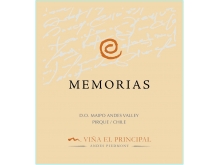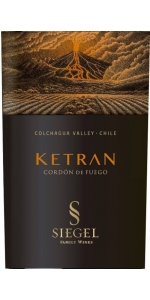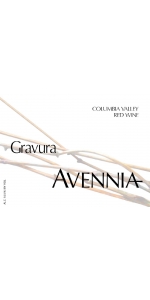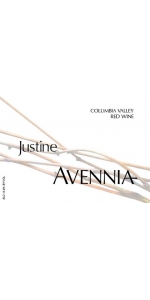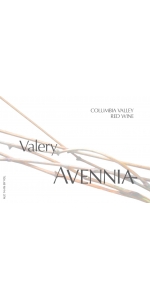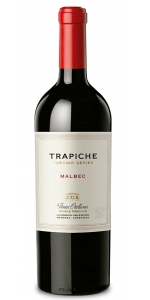Principal Memorias Red Blend 2014
| Country: | Chile |
| Region: | Colchagua Valley |
| Winery: | El Principal |
| Grape Type: | Cabernet Sauvignon |
| Vintage: | 2014 |
| Bottle Size: | 750 ml |
Siegel Ketran Red Blend is made from 35% Syrah, 30% Petit Verdot, 25% Carmenere, 10% Cabernet Franc
Ketran is coming from the Mapuche Language and it means "plowed earth". In fact, Earth was plowed by fire from the volcanic acitivity. Ketran is a tribute to the volcanic soils that gave birth to the fantastic terroir of Los Lingues, located at the foothills of the “Cordillera de los Andes".
The wine is clean and bright in color.
The wine displays a very aromatic and elegant nose of ripe black fruit, prune and dried fig.
The mouthfeel is smooth and the length to the finish is quite exceptionnal, with sweet and fleshy tannins, balanced by a perfectly integrated acidity which gives the wine some freshness and emphasizes the presence of fruit and its ability to age.
Coming from the volcanic soils of Los Lingues, at the foothills of the Andes mountain.
The wine went through ML fermentation, it was then aged 24 months in French Oak barrels.
The wine has been slightly filtered before bottling.
Review:
"2014 is the second release of Siegel's top red wine, made from a four-way cuvée of Syrah, Petit Verdot, Carmenère and Cabernet Franc. Plush, spicy and smoothly oaked, with some tannic backbone and a glossy finish. Needs time. 2021-30"
- Tim Atkin MW (Chile 2019 Special Report), 94 pts
Ketran is Siegel’s most ambitious wine. Debuting with the 2013 vintage, it’s a selection of the best barrel lots from Los Lingues in the Andean zone of Colchagua. The blend works very well, especially if you let the wine breathe for a few hours beforehand. The oak steps aside, and the aromas of fruit and herbs take over in a red with firm, sharp tannic structure that leaves room for the acidity—not very prominent in a warm year, but still present—to achieve balance. This blend is for the cellar.
-Patricio Tapia - Descorchados 94 Points
Avennia Gravura Red Blend is made from 48% Cabernet Sauvignon, 41% Merlot, 11% Cabernet Franc
Gravura is our ode to the Graves AOC of Bordeaux, emphasizing a harmony of Cabernet Sauvignon and Merlot. The name is a play on an artisan printing technique, and on the Bordeaux region of Graves, which features similar blends. Featuring more Merlot and with the addition of Red Mountain fruit, this wine is designed to be more generous and voluptuous in style, while still remaining complex and balanced.
Gravura Tasting Notes: Beautiful nose of red and black fruits, some savory leaf notes, mocha, pencil shavings. The palate is elegant and balanced, almost pretty: raspberry, black and red currants, milk chocolate and caressing tannins. Finish medium-long and ethereal.
Avennia Gravura Red Blend is made from 48% Cabernet Sauvignon, 41% Merlot, 11% Cabernet Franc
Gravura is our ode to the Graves AOC of Bordeaux, emphasizing a harmony of Cabernet Sauvignon and Merlot. The name is a play on an artisan printing technique, and on the Bordeaux region of Graves, which features similar blends. Featuring more Merlot and with the addition of Red Mountain fruit, this wine is designed to be more generous and voluptuous in style, while still remaining complex and balanced.
Gravura Tasting Notes: Beautiful nose of red and black fruits, some savory leaf notes, mocha, pencil shavings. The palate is elegant and balanced, almost pretty: raspberry, black and red currants, milk chocolate and caressing tannins. Finish medium-long and ethereal.
Avennia Justine Red Blend 56% Grenache, 31% Mourvèdre, 13% Syrah
Justine reflects our belief that Washington is capable of producing world class blends of grape varieties traditional to the Southern Rhone region of France. The name is inspired by one of the great heroines of recent literature, who also sprung from the imagination of the Mediterranean. Dark, seductive, complex, with a chasm of depth: The Justine is a great reflection of Avennia's mission of expression, and Washington's generous terroir.
Tasting Note: Big black cherry, blackberry, hints of orange peel, fresh herbs and loam on the nose. Plush and round on the palate. Dark earthy fruits from the Mourvedre, along with citrus high notes, mountain flowers, jasmine, and savory herbs. Balanced and complex without forgetting its hedonistic roots in the Southern Rhone.
Review:
A blend of 56% Grenache, 31% Mourvèdre, 13% Syrah brought up all in older oak, the 2016 Justine offers a great core of black fruits as well as lots of peppery herbs, earth, and classic meatiness. It looks to be a great vintage for this cuvée."
- Jeb Dunnuck (April 2018), 92-94 pts
Avennia Justine Red Blend 61% Grenache, 21% Mourvèdre, and 18% Syrah.
Justine reflects our belief that Washington is capable of producing world class blends of grape varieties traditional to the Southern Rhone region of France. The name is inspired by one of the great heroines of recent literature, who also sprung from the imagination of the Mediterranean. Dark, seductive, complex, with a chasm of depth: The Justine is a great reflection of Avennia's mission of expression, and Washington's generous terroir.
Tasting Note: Big black cherry, blackberry, hints of orange peel, fresh herbs and loam on the nose. Plush and round on the palate. Dark earthy fruits from the Mourvedre, along with citrus high notes, mountain flowers, jasmine, and savory herbs. Balanced and complex without forgetting its hedonistic roots in the Southern Rhone.
Avennia Valery Red Blend is made from 86% Merlot and 14% Cabernet Franc
Valery is named for the patron saint of wine in the St. Emilion region that inspired it.
We started with old vine Merlot from a stony block in the heart of the Yakima Valley and added complex, aromatic Cabernet Franc from the Horse Heaven Hills. The result is a balanced, complex wine with the elegance and ethereal perfume that this blend of two of Washington’s best varietals are known for.
The nose on this wine is very perfumed, almost exotic with notes of fresh violets, red plum, winter mint, fresh herbs and crushed limestone qualities. The palate is poised and balanced, with red fruits and mocha powder encapsulated in limestone. The finish lingers delicately, with the Cabernet Franc asserting a light tobacco and herb note, giving depth. A compelling wine that will continue to unwind for 7-10 years in the cellar.
Review:
"Brought up in 30% new French oak, the 2016 Valery (70/30 Merlot and Cabernet Franc) offers more black cherry and earthy, herbal notes as well as a medium-bodied, seamless, beautifully balanced style. It too shows a vibrant, fresh, yet concentrated style that has a Bordeaux feel in its weight and texture."
- Jeb Dunnuck (April 2019), 93 pts
"Good medium-dark red. Aromas of blueberry, mocha, licorice and violet are a bit darker than those of the 2015 version. Dense and penetrating, with wild flavors of dark berries, licorice and game given lift by rocky minerality and a minty nuance. Chris Peterson slightly acidified his Cabernet Franc from Champoux Vineyard, which he added to the wine for richness. This beauty may yet tighten up in the bottle.- Stephen Tanzer"
- Antonio Galloni's Vinous (November 2018), 92+ pts
Principal Memorias Red Blend is made from 63% Cabernet Sauvignon, 22% Syrah, 15% Petit Verdot.
The image on the label represents the "spiral of life", a symbol that is found in all major ancient civilizations that represents the cycle of life and the everlasting evolution.
Memorias is a Cabernet Sauvignon-based blend that includes Petit Verdot and Syrah, which was carefully crafted to achieve a perfect balance. It stands out for its great structure with soft and round tannins that will allow a complex evolution in the bottle.
Denomination of Origin: Maipo Andes Valley
63% Cabernet Sauvignon, 22% Syrah and 15% Petit Verdot.
Vineyard altitude: 780 meters above sea level.
Soil: Alluvial/colluvial origin, clay loam.
Climate: Sub humid Mediterranean with huge influence of the Andes Mountain.
pH: 3.57
Total Acidity: 5.94 g/L
RS: 2.0 g/L
Review:
Pirque is the highest area with vineyards in Alto Maipo. And El Principal has its vineyards in the highest area of Pirque. Memoria is a kind of second house wine and in which the winemaker Gonzalo Guzmán has been working intensely in search of greater freshness. This must be the best
- Descorchados (November 2017, 93 pts
"Gonzalo Guzman Cassanello collaborated on El Principal's wines with Patrick Léon, the longtime managing director of Bordeaux's Chateau Mouton-Rothschild, who first came to Chile in the 1990s to work on Almaviva. In the ripe 2014 vintage, they blended a relatively high proportion of syrah and petit verdot (22 and 15 percent, respectively) with cabernet sauvignon, creating an intriguing take on Pirque. Its flavors hint at ripe strawberries and darker notes of wild blackberries, the sweetness of that fruit held in a clean, light and delicate frame."
- Wine & Spirits Magazine (June 2019), 93 pts
The winery was named after the Picunche Chief Andetelmo, known as 'El Principal', master of the lands where the wintery at the foot of the Andes Mountains in the Alto Maipo Valley is located today.
The winery is owned and operated by two families - Jochen Döhle and the Said-Handal family.
Viña El Principal was orifinally a partnership between Jorge Fontaine, owner of the estate, and the French winemaker Jean Paul Valette, former owner of the famous Premier Grand Cru Classé Chateau Pavie in Saint-Émilion. Their goal was to produce a top-quality range of red wines that fully reflected the Chilean soul and the Valette family's heritage and experience in making fine wines. The El Principal terroir, located at the foot of the Andes Mountains in the Alto Maipo Valley was perfect for their project; its singular combination of climate, soil type, and altitude made ir ideal for producing wines with character, unique identity, and extraordinary quality.
Founded in 1992, Viña El Principal was originally a partnership between Jorge Fontaine, owner of the Hacienda El Principal, and the French winemaker Jean Paul Valette, former owner of the famous Premier Grand Cru Classé Château Pavie in Saint-Émilion.
Their goal was to produce a top-quality range of red wines that fully reflected the Chilean soul and the Valette family’s heritage and experience in making fine wines. The El Principal terroir, located at the foot of the Andes Mountains in the Alto Maipo Valley (D.O Maipo Andes) was perfect for their project; its singular combination of climate, soil type, and altitude made it ideal for producing wines with character, unique identity, and extraordinary quality.
The partners selected 54 hectares of the property to plant Cabernet Sauvignon and Carmenere varieties. Ten years later, the first vintage of the winery’s icon, the 1999 El Principal, was successfully released earning the international recognition as one of the Ultra Premium Chilean wines and confirming the potential of Chile as a world-class denomination of origin.
Today, El Principal is a family-owned winery. German shipowner Jochen Döhle bought the winery in 2005 and later partnered with the renowned Chilean Said-Handal family, who acquired 50 percent of the ownership in 2013. From the beginning, Mr. Döhle has been determined to continue making high quality wines, and his strategy has included planting additional hectares, searching for new varieties, and investing in equipment and storage facilities. Together the two families have overseen the execution of this strategy while maintaining the tradition and distinct identity of its wines.
51 ha - Cabernet Sauvignon
17 ha - Carmenere
17 ha - Syrah, Cabernet Franc, Petit Verdot and Malbec
2.1 ha - Verdejo
Under his direction, El Principal has slowly envolver from a Cabernet Sauvignon-Carmenere blend to a more sophisticated and elegant blend of Cabernet Sauvignon and Petit Verdot. He has also made fine adjustments to the winery's Memorias and Calicanto wines to enhance their freshness and complexity.
In his passion to discover what this terroir is able to produce, Guzmán has planted new Spanish varieties such as Verdejo, Albariño, Graciano, and Mencia with great success. In 2014 Viña El Principal launched Kiñe, the first New World Verdejo wine.
The renowned Bordeaux consultant Patrick Léon, who joined the Viña El Principal team in 2006, has been crucial in the winery’s purist approach to winemaking. His talent and unparalleled experience in producing high quality wines has established him as a consulting winemaker for some of the most prestigious wineries in the world.
Patrick was the Technical Manager of Château Lascombes Crus Classé in Margaux and Château Castera in Lesparre-Médoc, and he also spent two decades as the Managing Director for Baron Philippe de Rothschild, where he oversaw the company’s vineyards and winemaking facilities for Château Mouton Rothschild, Clerc Milon, Le Petit Mouton, Aile d’Argent, Opus One in California, Almaviva in Chile, Domaine de Lambert and Domaine de Baron’arques in the Languedoc, and Mouton Cadet in Bordeaux.
THE ANDETELMO ESTATE: A UNIQUE TERROIR
There are many factors that contribute to the uniqueness of El Principal wines, and one of the most important is its exceptional terroir. The Andetelmo Estate now consists of 90 hectares of vineyards in the Alto Maipo Valley (D.O Maipo Andes), at the foot of the Andes Mountains, 750 to 950 meters above sea level.
Geographical influences have generated a diversity of soil types that allow each grape variety to reach its finest expression and lend a particular character to the wines. The varied soils present a true mosaic of colluvial, alluvial, and gravel-cone collections and deposits. The hills have light-colored clay marbled with lime sediments, stone, and gravel, which allows for good drainage.
Furthermore, the mineral-rich waters of the Maipo River that flows through the vineyard also lend subtle complexity to the wines. The cooling effects of the Andean winds and the Humboldt Current create particular climate conditions and a broad daily temperature oscillation of more than 20ºC. This slows the ripening process and allows the grapes to develop intense fruit flavors with high concentrations of polyphenols, deep color, and ripe, elegant tannins.
THE VINEYARD
El Principal wines are made exclusively with grapes grown at the Andetelmo Estate in the Alto Maipo Valley. The vineyard has been mapped into micro-zones that consider soil, altitude, solar exposure, and climate to identify the perfect blocks for producing the best quality grapes for each wine.
The grapes are harvested entirely by hand with controlled production and the sorting of clusters both in the field and again at the winery. The grapes are lifted to the top of the tanks to achieve gentle gravity-flow filling and thus avoid using pumps. The vinification process begins with a 5-day cold maceration at 8º–10ºC, followed by alcoholic fermentation, which lasts 8–14 days at temperatures that fluctuate between 28ºC and 30ºC using gentle manual pumpovers managed in accordance with the concentration and degree of ripeness of the grapes to ensure a gentle and controlled extraction.
This traditional Bordeaux vinification process and later ageing in French oak ensures the inimitable character of El Principal wines that reflect the elegance and identity of their terroir.
WINEMAKING CONCEPT
Viña El Principal's oenology develops starting with the vineyards. The wines are exclusively processed with grapes grown on the lands, where the vineyards are continually studied as to their physiology and their relation to the terroir, in order to identify and perfect the best plots and thus obtain top quality raw material. Harvesting is carried out entirely by hand, with controlled production and the sorting of clusters both in the field and later in the wine cellars. This is followed by a careful traditional Bordeaux vinification process and ageing in French oak, resulting in the inimitable character of these wines capable of reflecting the elegance and identity of the terroir.
VINIFICATION
The winemaking process starts with a harvesting entirely by hand and sectorized. Later, also by hand, in the wine cellar and on a vibrating table, the best clusters are selected before entering the de-stemmer. An optical selector is used to pick out the best fruit. The grapes are raised to the upper part of the tanks to achieve gravity flow filling and thus avoid the use of a pump. Later, cold maceration (between 8 and 10ºC) takes place for 5 days, followed by the start of the alcoholic fermentation which is prolonged for 8 to 14 days at a temperature fluctuating between 28ºC and 30ºC, with gentle manual remontage according to the concentration and maturation of the grapes. This ensures a gentle and controlled extraction.
Trapiche Terroir Series Finca Orellana is made from 100 percent Malbec.
The history of Trapiche begins in 1883, in a small vineyard called El Trapiche, in the district of Godoy Cruz, Mendoza, where the grapes for the first fine wines were grown. With more than 130 years of experience, Trapiche has earned its place as a pioneering brand in the introduction of French vines, the production of varietal wines, the import of French oak barrels and the use of stainless steel tanks. True to its origins, today Trapiche is in a continuous quest for the latest best practices .Led by Daniel Pi, Director of Winemaking, Trapiche's winemaking team permanently strives to improve winemaking practices by exchanging experience and knowledge with winemakers from other wine producing countries such as France, the US, Australia and New Zealand.
With a deep garnet red color, this Malbec expresses aromas of red fruits such as cherries and currants, and intense balsamic notes with hints of fresh herbs. In the mouth, it is sweet and broad with a great concentration of fruit and soft, ripe tannins. It has a long, persistent and elegant finish.
Review:
El Peral may not be on the radar of many Argentine Malbec lovers. But if you take a look at Descorchados, you will realize that here we are fans of this area, a place of gentle hills, streams and trees. This vineyard was planted in 1946, and today it delivers deliciously liquefied fruit, with hints of cherries and cassis, but above all violets and blackberries in a long and deep body. Give it at least ten years in the bottle.
-Patricio Tapia - Descorchados 95 Points
-Tim Atkin 95 Points
- back
Continuum Red Blend 2021 is made from 45% Cabernet Sauvignon, 35% Cabernet Franc, 11% Merlot, 9% Petit Verdot.
A vintage set apart for its perseverance and resilience, the 2021 Continuum is one of refined concentration – a resounding expression of both measured intensity and enduring vibrancy. This is a multi-layered magnificent vintage that reveals floral notes, with black cherry and wild foraged mixed berries throughout. One can perceive the chemise, sage, and bay giving a gorgeous savory expression, reflective of the natural environment that surrounds the Sage Mountain Vineyard. 2021 is a wine of incredible complexity and nuance – a wine for the ages.
WINEGROWING- Continuum is estate grown on our Sage Mountain Vineyard. It’s location, high on Pritchard Hill along the eastern ridge above Oakville, overlooks Napa Valley and the San Francisco Bay. The rocky, volcanic soils of the site focus the vine’s energy keeping yields low yielding fruit of depth and complexity. 38 acres of mature estate vineyard, planted in 1991 and 1996, with additional plantings in 2004, 2010, together comprise 38 distinct vineyard blocks. Cabernet Sauvignon, Cabernet Franc, Petit Verdot, and Merlot are grown from 1300 to 1600 feet in elevation, on western and southern facing aspects with slight northern and eastern slopes in places. This diversity of plantings on our volcanic soils are the essence of the complexity of Continuum.
PRODUCTION- Continuum is 100% estate grown, produced and bottled. All fruit is selectively hand-harvested at night. The fruit is then sorted before and after de-stemming, and gravity fed into French oak or concrete tanks. A threeday cold soak is followed by fermentation, receiving three to four pumpovers daily, and délestage two to three times in total during the most active period. The wine remains on skins in tank for 20 to 40 days. All lots are then drained, basket pressed, and transferred with lees for malolactic fermentation and aging. Continuum spent 22 months in barrel. 63 percent of French oak barrels were new and 35 percent were once used. A single concrete amphora was also used for aging. The wine clarified slowly and settled naturally in our cold barrel room, was racked sparingly and bottled without fining or filtration. Each vineyard lot was tasted and carefully considered many times to assemble the blend. TASTING NOTES- Continuum shows energy and verve. The wine expresses purity and precision, with high tone aromatics of red and blue fruit, deep plum and rose oil. This vintage shows an approachable nerve of the land in the refined mineral quality on the palate. The surrounding native vegetation of bay and sage is evidenced in an earthy, savory profile. This is a shimmering, silky and harmoniously integrated wine with densely packed fine grain tannins.
DECANTING- For the fullest sensory experience we encourage decanting to allow the wine to breathe before serving. Decanting awakens the wine’s more purely fragrant expression and enhances the suppleness of the palate. Continuum is accessible and enjoyable upon release; however extended aging will be richly rewarded.
Review:
This is so aromatic with blackcurrant, blackberry, graphite, iron, pine bark and orange peel. Hints of wild sage and peppermint. Seductive perfumes. Full-bodied with extremely well-integrated tannins that have great length. Elegant firmness at the finish. The quality of the tannins is some of the best I have had in a young Continuum. Seamless silk. Great finish. 45% cabernet sauvignon, 35% cabernet franc, 11% merlot and 9% petit verdot. Best after 2027.
-James Suckling 99 Points
This note is written before the final blend of the 2021 Continuum. Deep purple-black in color, it hits the ground running with an intense nose of red and black currant preserves, lilacs, baker's chocolate, and graphite, leading to an undercurrant of black olives and red loam. On the medium to full-bodied palate it is very lively, grainy and super-concentrated, finishing long and shimmery.
-Wine Independent 98-100 Points
Yalumba The Signature Cabernet Sauvignon Shiraz is made from 54% Cabernet Sauvignon, 46% Shiraz.
Encompassing everything the Hill-Smith family stands for and the perfect representation of Yalumba’s history and ethos, The Signature is a sentimental favorite. A classic Australian blend of Cabernet Sauvignon and Shiraz, the first vintage release of The Signature was in 1962. Since then, this outstanding wine has acknowledged more than 57 Signatories; people who have enhanced the traditions and culture of Yalumba.
Seductive and alluring florals, cool mints, red pomegranate with fine blackberry fruits and dark cherry aromas. The palate is delightfully generous with dark red cherry fruit that merges into ironstone tannins. A medium to full bodied wine with a long, flowing tannin profile.
Review:
The 2018 The Signature Cabernet Sauvignon Shiraz (the 48th vintage) is named for Nick Waterman (managing director and CEO of Yalumba 2015 - 2022). The 2018 vintage in South Australia (and specifically here, Barossa) was an excellent one: ripe/warm, even and long and produced wines with density, energy and gravitas. This is exactly that: plush and powerful. The fruit forms a perfect dovetail: the enveloping, mouth-filling abundance of the Shiraz, neatly wedged into the folds of the structuring and shapely Cabernet. Very impressive. This is one of the more impressive Signatures in recent times. It will cellar with grace and ease.
-Robert Parker 96 Points
Since its first release in 1962, The Signature has been Yalumba's deep dive into the classic Australian blend from the Barossa and one that honors the people who have enhanced the traditions and culture of Yalumba. There is a resonance and depth to this release that I really like. Wonderfully pure and concentrated blackberry and plum fruits, layered with spice, dark chocolate, earth, cedar and oak nuance. Succulent and sinewy in the mouth, it flexes considerable muscle, yet remains purely fruited and approachable even at this stage of its evolution. Rich and balanced with fine, ripe tannin and plenty of energy for such depth of fruit. Lovely.
- Australian Wine Companion 96 Points

